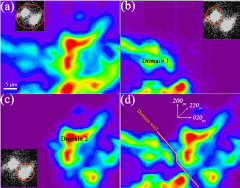The transition-metal monoxide FeO is an archetypal example of a Mott insulator—a material that should conduct electricity under conventional band theories but becomes an insulator when measured, especially at low temperatures—and a major iron-bearing component of the Earth’s interior. Understanding the high-pressure behavior of this material is important for both solid-state physics and Earth science. But despite considerable study over the past 30 years, the origin of the well-known high-pressure-induced cubic-rhombohedral ferroic transition in FeO, which is a distortion of the original cubic structure to that of as rhomboid shape, has been not well understood.
Now the first imaging of non-reflection domain wall structures forming in the ferroic transition of the ferrous oxide Fe0.94O has been reported by researchers from the U.S. Department of Energy Office of Science’s Advanced Photon Source (APS) and the High Pressure Synergetic Consortium (HPSynC). The team carried out the study at the 2-ID-D x-ray beamline at the APS, applying a pressure of approximately 250,000 atm in a pressure vessel called a diamond anvil cell, and imaging the material’s crystalline structure using the new high-pressure nanodiffraction imaging technique developed by these researchers.
The team’s results revealed a non-reflection type of domain wall structure forming due to the so-called “cubic-rhombohedral transition,” where the crystal structure of the material changes from cubic to rhomboidal. This discovery suggests the cubic-rhomboid transition could be associated with defects in the material and is unlikely to be caused by ferroelasticity, in which a material may develop a spontaneous strain, as predicated by previous research.
The surprising impact of defects on structural stability discovered by this study not only brings with it a new understanding of the origin of the cubic-rhomboid transition, but also underscores the need for a greater understanding of how defects in a material influences electronic and thermoelastic properties at high pressure, which has almost never been taken into consideration in previous high-pressure studies of materials.
In addition, this study demonstrates the power of the new nanodiffraction imaging technique for investigation of pressure-induced phase transitions, which has emerged as a very active area in condensed matter physics, but until now has lacked suitable in situ techniques for probing the nanoscopic origins of the transitions.
See: Yang Ding1,2,* Zhonghou Cai2, Qingyang Hu3, Hongwei Sheng3, Jun Chang2,4, Russell J. Hemley2, and Wendy L. Mao6, “Nanoscale diffraction imaging of the high-pressure transition in Fe1-xO,” Appl. Phys.Lett. 100, 041903 (2012). DOI: 10.1063/1.3679117
Author affiliations: 1Argonne National Laboratory, 2Carnegie Institution of Washington, 3George Mason University, 4Northern Illinois University, 5Carnegie Institution of Washington, 6Stanford University
Correspondence: *[email protected]; [email protected]
Use of the Advanced Photon Source at Argonne National Laboratory was supported by the DOE’s Office of Science under Contract No. DE-AC02-06CH11357.
HPSynC at the APS provides a new approach to high-pressure science using synchrotron radiation by establishing high-pressure environments at many beamlines of the APS for the science community, to make novel synchrotron techniques available to high-pressure researchers, and to establish a gateway for high-pressure scientists to many beamlines of the APS.
The Advanced Photon Source at Argonne National Laboratory is one of five national synchrotron radiation light sources supported by the U.S. Department of Energy’s Office of Science to carry out applied and basic research to understand, predict, and ultimately control matter and energy at the electronic, atomic, and molecular levels, provide the foundations for new energy technologies, and support DOE missions in energy, environment, and national security. To learn more about the Office of Science x-ray user facilities, visit http://science.energy.gov/user-facilities/basic-energy-sciences/
Argonne National Laboratory seeks solutions to pressing national problems in science and technology. The nation's first national laboratory, Argonne conducts leading-edge basic and applied scientific research in virtually every scientific discipline. Argonne researchers work closely with researchers from hundreds of companies, universities, and federal, state and municipal agencies to help them solve their specific problems, advance America's scientific leadership and prepare the nation for a better future. With employees from more than 60 nations, Argonne is managed by UChicago Argonne, LLC for the U.S. Department of Energy's Office of Science.

